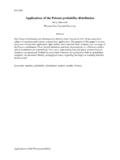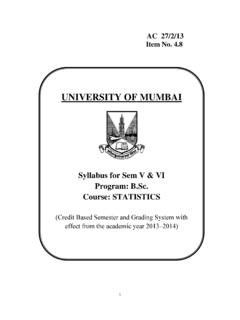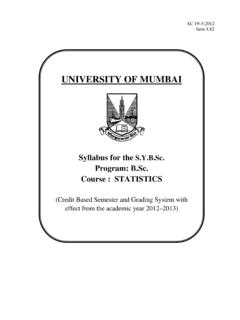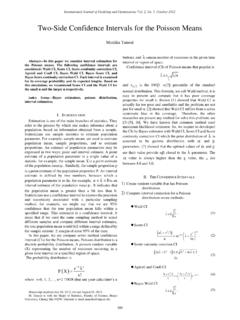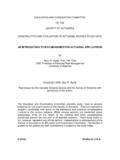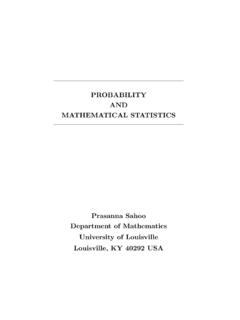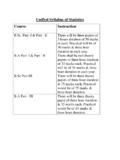Transcription of Probability Theory: The Coupling Method - Universiteit Leiden
1 Probability theory : The Coupling Method Frank den Hollander Mathematical Institute, Leiden University, Box 9512, 2300 RA Leiden , The Netherlands email: First draft: June 2010, LATEX-file prepared by H. Nooitgedagt. Second draft: September 2012, figures prepared by A. Troiani. Third draft: December 2012. 1. ABSTRACT. Coupling is a powerful Method in Probability theory through which random variables can be compared with each other. Coupling has been applied in a broad variety of contexts, to prove limit theorems, to derive inequalities, or to obtain approximations. The present course is intended for master students and PhD students. A basic knowledge of Probability theory is required, as well as some familiarity with measure theory . The course first explains what Coupling is and what general framework it fits into. After that a number of applications are described. These applications illustrate the power of Coupling and at the same time serve as a guided tour through some key areas of modern Probability theory .
2 Examples include: random walks, card shuffling, Poisson approximation, Markov chains, correlation inequalities, percolation, interacting particle systems, and diffusions. 2. PRELUDE 1: A game with random digits. Draw 100 digits randomly and independently from the set of numbers {1, 2, .. , 9, 0}. Consider two players who each do the following: 1. Randomly choose one of the first 10 digits. 2. Move forward as many digits as the number that is hit (move forward 10 digits when a 0 is hit). 3. Repeat. 4. Stop when the next move goes beyond digit 100. 5. Record the last digit that is hit. It turns out that the Probability that the two players record the same last digit is approxi- mately Why is this Probability so close to 1? What if N digits are drawn randomly instead of 100. digits? Can you find a formula for the Probability that the two players record the same last digit before moving beyond digit N ? PRELUDE 2: A game with two biased coins. You are given two coins with success probabilities p, p (0, 1) satisfying p < p (head =.)
3 Success = 1; tail = failure = 0). Clearly, it is less likely for the p-coin to be successful than for the p -coin. However, if you throw the two coins independently, then it may happen that the p-coin is successful while the p -coin is not. Can you throw the two coins together in such a way that the outcome is always ordered? The answer is yes! Let p = (p p)/(1 p) (0, 1). Take a third coin with success Probability p . Throw the p-coin and the p -coin independently. Let X be the outcome of the p-coin and X the outcome of the p -coin, and put X = X X . Because p = p + (1 p)p , X has the same distribution as the outcome of the p -coin (check this statement!). Since X X, you have thus achieved the ordering. 3. Contents 1 Introduction 6. Markov chains .. 6. Birth-Death processes .. 7. Poisson approximation .. 8. 2 Basic theory of Coupling 10. Definition of Coupling .. 10. Coupling inequalities .. 11. Random variables .. 11. Sequences of random variables.
4 12. Mappings .. 13. Rates of convergence .. 13. Distributional Coupling .. 14. Maximal Coupling .. 15. 3 Random walks 17. Random walks in dimension 1 .. 17. Simple random walk .. 17. Beyond simple random walk .. 18. Random walks in dimension d .. 20. Simple random walk .. 20. Beyond simple random walk .. 20. Random walks and the discrete Laplacian .. 21. 4 Card shuffling 23. Random shuffles .. 23. Top-to-random shuffle .. 24. 5 Poisson approximation 28. Coupling .. 28. Stein-Chen Method .. 29. Sums of dependent Bernoulli random variables .. 29. Bound on total variation distance .. 31. Two applications .. 33. 6 Markov Chains 35. Case 1: Positive recurrent .. 35. Case 2: Null recurrent .. 37. Case 3: Transient .. 38. Perfect simulation .. 39. 7 Probabilistic inequalities 40. Fully ordered state spaces .. 40. Partially ordered state spaces .. 41. Ordering for Probability measures .. 41. Ordering for Markov chains .. 43. The FKG inequality .. 45. 4. The Holley inequality.
5 48. 8 Percolation 50. Ordinary percolation .. 50. Invasion percolation .. 51. Invasion percolation on regular trees .. 53. 9 Interacting particle systems 57. Definitions .. 57. Shift-invariant attractive spin-flip systems .. 58. Convergence to equilibrium .. 59. Three examples .. 60. Example 1: Stochastic Ising Model .. 60. Example 2: Contact Process .. 61. Example 3: Voter Model .. 61. A closer look at the Contact Process .. 62. Uniqueness of the critical value .. 62. Lower bound on the critical value .. 62. Upper bound on the critical value .. 63. Finite critical value in dimension 1 .. 64. 10 Diffusions 68. Diffusions in dimension 1 .. 68. General properties .. 68. Coupling on the half-line .. 69. Coupling on the full-line .. 70. Diffusions in dimension d .. 71. 5. 1 Introduction In Sections we describe three examples of Coupling illustrating both the Method and its usefulness. Each of these examples will be worked out in more detail later. The symbolN0.
6 Is used for the set N {0} with N = {1, 2, ..}. The symbol tv is used for the total variation distance, which is defined at the beginning of Chapter 2. The symbols P and E are used to denote Probability and expectation. Lindvall [10] explains how Coupling was invented in the late 1930's by Wolfgang Doeblin, and provides some historical context. Standard references for Coupling are Lindvall [11] and Thorisson [15]. Markov chains Let X = (Xn )n N0 be a Markov chain on a countable state space S, with initial distribution = ( i )i S and transition matrix P = (Pij )i,j S . If X is irreducible, aperiodic and positive recurrent, then it has a unique stationary distribution solving the equation = P , and lim P n = componentwise on S. ( ). n . This is the standard Markov Chain Convergence Theorem (MCCT) (see H aggstr . om [5], Chapter 5, or Kraaikamp [7], Section ). A Coupling proof of ( ) goes as follows. Let X = (Xn )n N0 be an independent copy of the same Markov chain, but starting from.
7 Since P n = for all n, X is stationary. Run X and X together, and let T = inf{k N0 : Xk = Xk }. be their first meeting time. Note that T is a stopping time, , for each n N0 the event {T = n} is an element of the sigma-algebra generated by (Xk )0 k n and (Xk )0 k n . For n N0 , define . Xn , if n < T, Xn =. Xn , if n T. By the strong Markov property (which says that, for any stopping time T , (Xk )k>T depends on (Xk )k T only through XT ), we have that X = (Xn )n N0 is a copy of X. Now write, for 6. i S, ( P n )i i = P(Xn = i) P(Xn = i). = P(Xn = i, T n) + P(Xn = i, T > n). P(Xn = i, T n) P(Xn = i, T > n). = P(Xn = i, T > n) P(Xn = i, T > n), where we use P as the generic symbol for Probability (in later Chapters we will be more careful with the notation). Hence X. k P n ktv = |( P n )i i |. i S. X . P(Xn = i, T > n) + P(Xn = i, T > n) = 2P(T > n). i S. The left-hand side is the total variation norm of P n . The conditions in the MCCT. guarantee that P(T < ) = 1 (as will be explained in Chapter 6).
8 The latter is expressed by saying that the Coupling is successful. Hence the claim in ( ) follows by letting n . Birth-Death processes Let X = (Xt )t 0 , be the Markov process with state space N0 , birth rates b = (bi )i N0 , death rates d = (di )i N0 (d0 = 0), and initial distribution = ( i )i N0 . Suppose that b and d are such that X is recurrent (see Kraaikamp [7], Section , for conditions on b and d that guarantee recurrence). Let X = (Xt )t 0 be an independent copy of the same Markovv process, but starting from a different initial distribution = ( i )i N0 . Run X and X together, and let T = inf{t 0 : Xt = Xt }. be the first time X and X meet each other. For t 0, define . Xt , if t < T, Xt =. Xt , if t T. The same argument as in Section gives k Pt Pt ktv 2P(T > t), where Pt is the transition matrix at time t, , ( Pt )i = P(Xt = i), i N0 . Since transitions can occur between neighboring elements of N0 only, X and X cannot cross without meeting. Hence we have T max{ 0 , 0 }.
9 7. with 0 = {t 0 : Xt = 0}, 0 = {t 0 : Xt = 0}, the first hitting times of 0 for X and X , respectively. By the assumption of recurrence, we have P( 0 < ) = P( 0 < ) = 1. This in turn implies that P(T < ) = 1, , the Coupling is successful, and so we get lim k Pt Pt ktv = 0. t . If X is positive recurrent (see Kraaikamp [7], Section , for conditions on b and d that guarantee positive recurrence), then X has a unique stationary distribution , solving the equation Pt = for all t 0. In that case, by picking = we get lim k Pt ktv = 0. ( ). t . Remark: The fact that transitions can occur between neighboring elements of N0 only allows us to deduce, straightaway from the recurrence property, that the Coupling is successful. In Section this argument was not available, and we had to defer this part of the proof to Chapter 6. In Chapter 6 we will show that the Coupling is successful under the stronger assumption of positive recurrence. Poisson approximation Let Ym , m = 1.
10 , n, be independent {0, 1}-valued random variables with P(Ym = 1) = pm , m = 1, .. , n, Pn and put X = m=1 Pn Ym . If all the pm 's are small, then X is approximately Poisson distributed with parameter m=1 pm (see Rice [13], Section ). How good is this approximation? For > 0, define i p (i) = e , i N0 , i! which is the Poisson distribution Pn with parameter , abbreviated as POISSON( ). Let X have distribution p with = m=1 pm . Then, for i N0 , P(X = i) p (i) = P(X = i) P(X = i). = P(X = i, X = X ) + P(X = i, X 6= X ). P(X = i, X = X ) P(X = i, X 6= X ). = P(X = i, X 6= X ) P(X = i, X 6= X ). and hence kP(X ) p ( )ktv 2P(X 6= X ). ( ). Thus, in order to get a good approximation it suffices to find a Coupling of X and X that makes them equal with high Probability . Choosing them independently will not do. Here is how we proceed. Let (Ym , Ym ), m = 1, .. , n, be independent {0, 1} N0 -valued random variables with distribution .. 1 pm , if i = 0, i = 0.
